|

 Up
Up 
 Help with
Help with
Homework

(You are here.)
 Down
Down




  Need
to Need
to
find your
bearings?
Try
these
navigation aids:
If
this is your first
visit, please stop by:
Something
to share?
Please:



|
|
Available in Française, Español, Português, Deutsch, Россию,
中文,
日本, and others.
 f
you're looking for help with a paper on the Wright brothers, or
you're involved in a History Day project, we've collected some
information that you may find useful: f
you're looking for help with a paper on the Wright brothers, or
you're involved in a History Day project, we've collected some
information that you may find useful:
Also check out our
Resources
page where we have listed many books, videos, libraries, archives,
museums, and web links where you can find additional information of
the Wright brtohers.
|
|
|
|
Primary
Sources
When writing an report on an historical event, your most reliable sources are
eyewitness accounts from people who actually saw or participated in the event.
These are called primary sources. The best primary sources for the
invention of the airplane are the Wright brothers themselves, who -- fortunately
for us -- left behind reams of letters, diaries, photographs, technical papers,
and other first-person accounts of their experiments. We also have a good many
reports from relatives, friends, neighbors, employees, and associates who knew
them well and were part of their lives.
Where you dive in to the first-person accounts and how deeply you dive
depends on what you already know about the Wright brothers, your level of
interest, and/or just how determined your are to get a good grade on your
report. We've listed the primary sources here in the suggested order in which
you should read them if you're starting with nothing more than what you've
gleaned from general history books.
Note: Click on the covers to the left
to see a Table of Contents for each book.
1. Wright, Orville, How We Invented the Airplane: An Illustrated
History, edited by Fred C. Kelly, New York, Dover Publications, 1988.
This is a short book (88 pages), lavishly illustrated with lots of photos.
(Bottom line -- it's a great primary source that won't take you long to read.)
It's a collection of several magazine articles written by Orville Wright in
which he tells the story of the invention of the airplane in his own words.
The articles are strung together with commentary by Fred C. Kelly, a friend of
Orville's and the official biographer of the Wright Brothers, to help you
understand the whole story.
2.
Kelly, Fred C., The Wright Brothers: A Biography, New
York, Harcourt, Brace, and Company, 1943. Republished by Dover
Publications in 1989.
Although Fred Kelly is listed as the author of this
book, this is really an "as told to" biography -- the story of the
Wright brothers as told to Fred Kelly by Orville Wright. Kelly worked closely
with Orville to create an "authorized" account of the invention of
the airplane. Orville told Kelly the particulars of the story, then edited the
final manuscript, so we have his assurance that Kelly's telling of the tale is
as accurate as his own. In that sense, this can be considered a primary
resource. It's a medium-size book (340 pages) and provides a full, detailed
account of the lives of the Wright brothers.
3. Wright, Orville and Wilbur, Miracle at Kitty Hawk: The Letters
of Wilbur and Orville Wright, edited by Fred C. Kelly, New York,
Farrar, Straus & Giroux, Inc., 1951. Republished by Dover
Publications in 1996.
Now you're getting to the heart of the matter. This
large book (482 pages) contains extracts from the letters and diaries of the
Wright brothers. Kelly has strung them together in such a way as to create a
first-person account of the invention of the airplane and the lives of the
Wright brothers in detail. You learn what the brothers were thinking and why
they did what they did at every turn of the story.
4. Miller, Ivonette Wright, Wright Reminiscences, Dayton,
Ohio, The Air Force Museum Foundation, 1978.
This will help fill in the story with first-hand
accounts from people who knew the Wright brothers intimately. Ivonette Wright
Miller was Lorin Wright's daughter and a niece of Wilbur and Orville Wright.
She was at their home often to visit her uncles, her aunt (Katharine Wright),
and her grandfather (Bishop Milton Wright). Along with the other relatives and
friends whose reminiscences she has collected, Ms. Miller paints an intimate
picture of life in the Wright household.
|
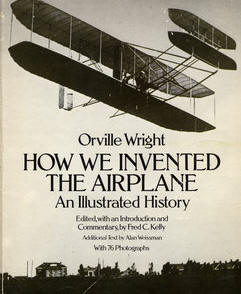
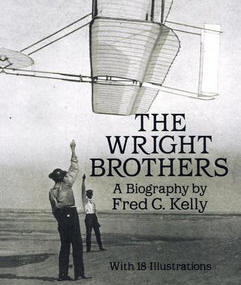
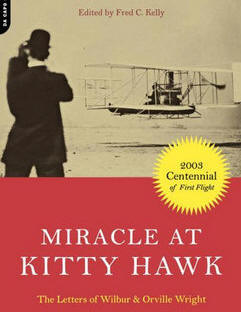
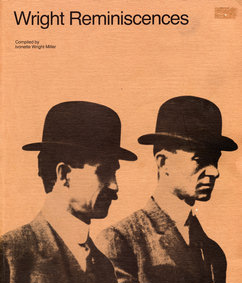
|
|
|
In-Depth Research
If you really get hooked on the story (many people do) and you're hungry for
the minute details of the Wright adventure, there are two more primary sources
that you can consult:
5.
Wright, Orville and Wilbur, The Papers of Wilbur & Orville
Wright, Volumes 1 and 2, edited by Marvin W. McFarland. New York: McGraw-Hill, 1953.
This is a greatly expanded collection of letters and
papers, much like Kelly's Miracle at Kitty Hawk, but with three times
the information. (Together, volumes 1 and 2 contain 1278 pages.) This is a
must if you're after the engineering side of the story -- Orville and Wilbur's
most important technical papers are included here.
6. Jakab, Peter L. and Young, Rick, The Published Writings of
Wilbur and Orville Wright, Washington, D.C., Smithsonian
Institution Press, 2000.
You could consider this a companion book to McFarland's
volumes (above). This contains many of the magazine articles,
interviews, technical papers, and other writings that the Wright brothers
published in contemporary newspapers, magazines, and journals.
For additional books, pamphlets, and videos on the Wright brothers, see our
bibliography at Books, Movies, &tc.
|
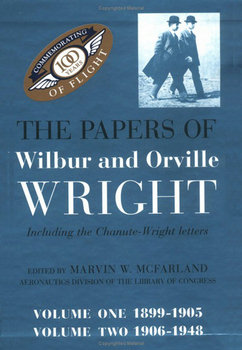

|
|
|
Interlibrary Loan
If you're library doesn't have one of the
primary sources we've mentioned here, don't panic. You should be able to
get them through "interlibrary loan." This is a service that most
large libraries offer. If you need a book that's not on the shelves in your
local library, ask the librarian for an interlibrary loan form. Fill it out with
the information on this page and then submit it to the librarian. They will do a
computer search to find the closest library with the book available for loan
and order it for you. When it comes in, they will notify you. Then you can borrow the
book, usually for the same amount of time as the other books in your local library.
|
|
|
Wright Photos
Many of you have written in asking where you can get copies of Wright photos
to make History Day displays or help illustrate your reports. How about
right HERE? For free! The catch is that you have to download them and
print them out yourself.
We've put up 48 photos that tell the story of the invention of
the airplane from 1899 when the Wright brothers conducted their first
aeronautical experiment to 1909 when they finally began selling practical
airplanes. Choose the photos you want and download the high-resolution images by
following the instructions at the top of the page. Once you have downloaded the
high-res files, you can print out large, detailed images on an ordinary inkjet
or laser printer. For best results, print these out on glossy "photo"
paper made especially for computer printers. This paper is available at most
office supply and computer stores. Teachers: You can use these hi-res
images as posters for classroom decoration or as digital slides in presentations.
If you want to include these photos in reports, you will probably want to
resize them so the files aren't quite so big. Otherwise the report file will be
massive and your computer may have a hard time digesting it when you print it
out. Resize the photos to a 640 x 400 screen -- this should reduce most of them
to a file size of between 50K and 100K.
|

Orville (left) and Wilbur (right) at an air meet in New York in
1910.
|
|
|
Wright Timeline
Sometimes a timeline gives you a succinct overview of an historical event and
shows how it developed. To help understand the invention of the
airplane, here's a brief chronology of the Wright brothers lives.
If you'd like
a more detailed timeline that puts the Wright story in its perspective with
other important events, click
HERE.
- 1867 — Wilbur Wright is born
near Millville, Indiana.
- 1871 — Orville Wright is born
in Dayton, Ohio.
- 1878 — Wright brothers build
their first aircraft, a rubber-band powered helicopter they call a
"bat."
- 1885 — A sports injury leads to
health problems that prevent Wilbur from attending college.
- 1886 — Orville starts a
printing business while he is still in high school.
- 1889 — Orville publishes a
newspaper, the "West Side News," and Wilbur joins him as editor. The
newspaper business does not profit and the Wrights return to "job" printing.
- 1893 — The Wright brothers
begin to sell and repair bicycles.
- 1895 — The Wrights manufacture
their own bicycles, the "St. Clair" and the "Van Cleve." The
bike business is profitable.
- 1896 — The Wrights take an
interest in the "flying problem."
- 1899 — Wilbur devises
an aerodynamic control system for aircraft and builds a kite to test it.
- 1900 to 1902 — The Wright
brothers fly gliders at Kitty Hawk, North Carolina, refining their control
system. At home in Dayton, Ohio, they build a wind tunnel and conduct research
on wing shapes.
- 1903 — The Wright brothers make
the first controlled, sustained powered flights at Kitty Hawk.
- 1904 to 1905 — The Wrights
develop a practical airplane near Dayton.
- 1908 — The Wright brothers
demonstrate a two-passenger airplane in Europe and America.
- 1909 — The Wrights begin to
manufacture airplanes.
- 1912 — Wilbur Wright dies of
typhoid in Dayton, Ohio.
- 1915 — Orville Wright sells his
airplane- company.
- 1932 — The Wright Brothers
Monument at Kitty Hawk is dedicated.
- 1938 — The Wright Bicycle Shop
and Wright home are opened to the public at Henry Ford Museum/Greenfield
Village.
- 1948 — Orville Wright dies of a
heart attack in Dayton, Ohio and the Wright brothers' first powered airplane,
the 1903 "Flyer," is enshrined at the Smithsonian Institution.
If you have a broader interest in
pioneer aviation, see
A History of the Airplane. The section titled
The Century Before presents a timeline of events leading up to
the first flights, and the section called
The Decade After is a timeline of the pioneer aviation era. For serious scholars who wish to
consult a day-to-day chronology on the Wright brothers' lives, we
offer George Arnold Renstrom's classic,
Wilbur and Orville Wright: A Chronology in PDF format.
Renstrom's work also contains a detailed flight log of their glider
experiments, test flights at Huffman Prairie, training flights and
exhibition flights in Europe and America.
|

Wilbur Wright about the age he began to make rubber band-powered
"bats."
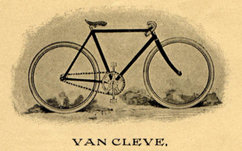
An advertisement for Wright bicycles.
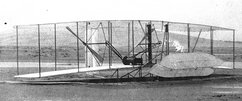
Damaged Flyer after its fourth flight on December 17, 1903.
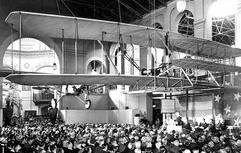
Flyer hanging in the Smithsonian in 1948.
|
|
|
Wright Flyer Models
Real and Virtual
If you want to build a model of a Wright airplane to help show
or demonstrate its features, we've put together a short list of the
commercially-available models in our page of
Wright Flyer Models.
There are several wooden and plastic kits to
choose from, as well as a selection of both simple and complex models.
And should you want to build a Flyer model from scratch, we also
provide a set of measured drawings that are detailed enough for most
modelers. They are, in fact, detailed enough to build a model for tests
in a small wind tunnel, if you really want to impress your teacher or
judges.
If you aren't the hands-on sort that enjoys building models,
maybe you'd like a virtual model for your report or project. We've
built a detailed, accurate digital replica of the 1903 Wright Flyer I and embedded
it in a 3D PDF file. This file can be viewed with Adobe Acrobat Reader 9.0
and later. (If you don't already have a copy of Acrobat Reader or want to
update your software, you can download the latest version for free by clicking
HERE.)
Once you have up-to-date Reader, simply click on the link to 3D PDF Flyer
file and it will load automatically with all the tools you need to zoom, pan, slide, and turn the
Flyer around. You can see it from all sides and angles, investigate every little
part. It's thoroughly geeky -- your
teacher should be suitably impressed. And if you're a teacher, this is a
great educational aid. Project the model on a screen or smartboard and use it to
explain how the Wright brothers developed the basic parts of the airplane.
|
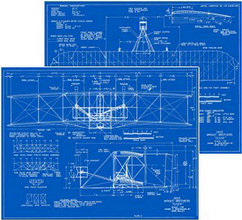
Measured drawings of the Flyer.
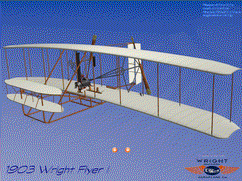
►Click
HERE to download a copy of the WBAC 1903 Wright Flyer I 3D PDF (about
11.8 Mb).
|
|
|
Wright flyer Plans and Drawings
The Wright Flyer was an amazing machine that incorporated many innovative
ideas that were cutting edge for the Wright
brothers' day – variable-camber flight surfaces, aluminum block engine, flight
recorder – the list goes on and on. Furthermore, it was the first powered
aircraft ever to have three-axis aerodynamic controls and it's not immediately
apparent how these work. To explain how to fly the airplane and to point out the
technology that made it work, it often helps to have a few drawings to which you
can refer. We've brought together a selection of standard and perspective views
at Wright Plans and Drawings so
you can choose the drawings that best suit your needs.
|
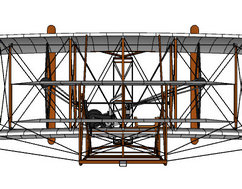
Center section of the 1903 Wright Flyer.
|
|
|
Wright Expert
Interview
We get hundreds of requests from students for interviews, mostly for "History
Day" projects or other academic programs. Unfortunately, we don't have the time
or manpower to grant them all. What we have done is to round up the "frequently
asked questions" that we have heard during previous student interviews. Then we
submitted them to our director, Nick Engler. You can read his answers
HERE. Please borrow
whatever quotes you need from this published interview for your project.
If you have a question that Mr. Engler has not answered, or you would
like him to provide a more detailed explanation for a question that he
has already answered, please contact us and submit your request. Mr.
Engler has promised to expand this published interview as he gets more
questions. Important Note: You might also want to take
advantage of an interview with the Wright brothers themselves.
See
Kate Carew's Interview in
Aviation's Attic.
|
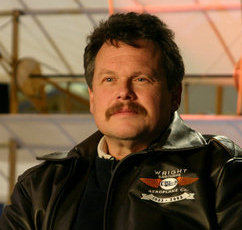 |
|
|
Information and
Brochures
Oftentimes, students write to us asking for printed information and
brochures. We don't have any to send you. While we understand that
having printed information to display scores points with teachers and
History Day judges, we don't have the time or the money to print stuff
and mail it. We have put all our effort into building this web site and
making it one of the most informative and complete resources on pioneer
aviation on the Internet. The information may not be printed, but it's
all here. That said, we have put together four concise, informative
pieces that you might show to teachers and judges. They are in PDF format
and you'll have to download and print them yourself if you need to show them
on paper. They are:
|
 |
|
|
Web Site Citation
If you need to cite this web site as one of your research sources, you can
assume that unless otherwise noted, the sponsor/owner is Bookworks, Inc.,
the publisher that sponsors this site. The pages were published between 1998 and
the present time, although we don't commonly list the date of publication for each
page. The author/editor is usually Nick Engler, our resident archaeologist and
webmaster. But we have many pages that have been contributed by other people,
even a few that were written by the Wright brothers themselves. Look for the
by-line, usually just under the title of the page. Or there may be a paragraph
in brackets from the editor that names the author is and tells a little bit
about them.
According the the MLA (Modern Language Association), a web citation
should include these elements:
- Author or editor's name, last name first, if available.
- Title of the article or web page in quotation marks.
- Web site name, italicized.
- Edition or version number, if any.
- Date of publication, as precise as possible. List as
day-month-year (e.g. 15 July 2009), just the year (e.g 2009) or "n.d."
if there is no precise date available.
- The word "Web" to indicate the medium.
- The owner, publisher or sponsor of the web site.
- The date you accessed the site and a period. Once again, follow
the standard day-month-year format.
- If required, the full web address in angle brackets (< >).
- Separate each bit of information with a period and put a period
at the end of the citation.
For example, if you were to cite this web page, the citation should
look like this:
Engler, Nick. "Help with Homework." Wright Brothers Aeroplane Company. n.d.
Bookworks, Inc. Web. 15 July
2009.<http://www.wright-brothers.org/information_desk/help_with_homework/help_with_homework.htm>.
|
|
|
|
Copyright Notice: Although we encourage you to make use of
the information and images in this section, you must respect them as
copyrighted property. We have provided this section as an educational
service to students, teachers, and scholars and you may use the text,
photos, and drawings freely in educational venues (student papers, class
projects, History Day displays, etc.) provided they are not
mass-produced. If your project requires publication in an electronic
media, such as a school web site, you must cite us as your source and
provide a hyperlink to the Wright Brothers Aeroplane Company web site,
www.wright-brothers.org.
Several of the publications in this section include our trademark logo,
and this logo may not be used outside these specific publications
without written permission of the trademark owner, nor may the
publications be duplicated without the trademark. All other uses of the
text and images, whether for profit, commerce, advertisement,
information, design, or mass media (such as, but not limited to,
documentaries, non-school web sites, and textbooks) are forbidden
without written permission of the copyright owner.
|
|
|
|

